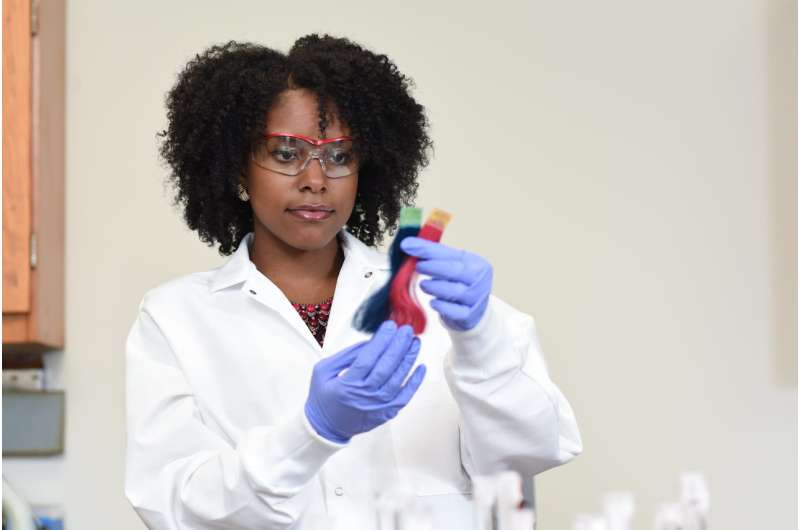Designing the next generation of hair dyes

North Carolina State University researchers have created the largest publicly available chemical database of hair dye substances as a resource for developing a new generation of hair color products that are safer for consumers, stylists and the environment.
The online Hair Dye Substance Database contains detailed information about the structure and properties of 313 substances in current and past commercial hair dyes. Using computer-based classification - what's known as cheminformatics - researchers grouped the dyes into clusters with similar structures and properties. The results revealed some surprises and promising new avenues for research.
"The database can definitely help drive design, not just of hair dyes but of other types of dyes, using the same approach," says Tova Williams, NC State doctoral student and lead author of a journal article about the research.
Coloring hair is a multibillion-dollar global business that's growing rapidly. Hair dyes are divided into three basic types, depending on how long they last. Temporary dyes, which coat the hair surface, wash out with one or two shampoos. Semi-permanent dyes last a bit longer - through six to eight washings.
About 80 percent of commercial hair dyes on the market, however, are permanent, created through the chemical process of oxidation. When permanent hair dye is applied, it's initially colorless. Tiny precursor molecules slip inside the core of hair fibers, where they "join hands" to form larger molecules and impart color, Williams says. Permanent hair color resists washing out because it's inside the hair shaft and chemically bonded.
Researchers can use the database to help identify dyes that are less likely to cause allergic reactions or increase cancer risk. Safety is a key concern for consumers because hair color sits on the scalp, as well as for stylists who work with dye products repeatedly over time.
"Using computer modeling allows us to make predictions about which substances in the database would be likely to cause skin sensitization or that might have a greater likelihood of health risks," Williams says. "This can lead to development of dyes that have better properties and are more sustainable."
Cheminformatics can expedite the research and development process, making it possible to analyze and compare the properties of hundreds of substances in the database - a feat that wouldn't be possible otherwise, says co-author Denis Fourches, assistant professor of chemistry at NC State.
"If you had to do this work with the hair dyes in a lab, it would take several years of work and several million dollars," Fourches says. "With more than 300 substances, it would be very challenging without computer modeling, which provides a transparent and reproducible way to characterize and classify dyes."
While creating the database, researchers found an intriguing group of dyes that didn't fit into established categories: a subcluster of semi-permanent dyes that seemed to have properties similar to the precursors in permanent dyes.
In fact, there's a whole tray of these dyes in NC State's Max A. Weaver Dye Library, a collection of thousands of dye and fabric samples that the Eastman Chemical Company donated to the university, says co-author Harold Freeman, professor of dye chemistry at NC State.
"One of the things that jumped out at us was the potential to connect this study with the dye library, with its 100,000 unique dyes," Freeman says. "By modifying the structure of key compounds in the dye library, we expect to design novel dye precursors that are environmentally benign, put them into hair and then transform them into colors to take advantage of the unique parent structures.
"There's so much potential now to use this group of dyes waiting in the wings to help us with design of hair dyes that will be not only effective but safe."
Researchers also considered the environmental impact of dyes. They linked the hair dye database with the U.S. Environmental Protection Agency's internal chemistry dashboard. Co-author Antony John Williams works at the EPA's National Center for Computational Toxicology in Research Triangle Park, North Carolina.
"Now that we've released the database into the public domain, other modelers are already interested in this group of hair dyes, which is a step toward designing new substances that are more sustainable and greener - less toxic," Fourches says. "They're calculating new types of properties that we aren't even thinking about right now, which is very exciting."
The study appears in ACS Sustainable Chemistry and Engineering.
More information: Tova N. Williams et al, Toward the Rational Design of Sustainable Hair Dyes Using Cheminformatics Approaches: Step 1. Database Development and Analysis, ACS Sustainable Chemistry & Engineering (2017). DOI: 10.1021/acssuschemeng.7b03795
Provided by North Carolina State University

















